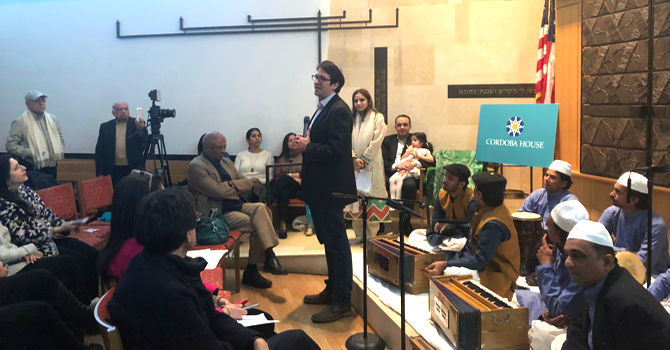Jews & Muslims Share Space and Life Together
Jews & Muslims Share Space and Life Together
Adapted from Jews and Muslims in New York bond over shared space and shared values (May 2021) by Martin Davis, with permission from Faith & Leadership.
In 2016, Naz Georgas, a Muslim woman, took a cab to East End Temple, a Reform synagogue in New York City.
The reason for her visit was to ask the synagogue leadership whether her organization could use space in their building. She was starting a new, pluralistic approach to teaching Muslim children, but she needed a place to gather.
“I was apprehensive,” she said. “What would I say to the rabbi? I remember thinking, ‘God, make this easy for me.’”
She had little to be apprehensive about.
With the blessing of the synagogue’s interim rabbi, Georgas began leading youth in religious education classes every Sunday at East End Temple, which is home to a congregation of about 350 families.
The synagogue had a “willingness … to be vulnerable and get to know people,” according to its current rabbi, Joshua Stanton. That openness has led to a remarkable interfaith relationship with Georgas’ organization, Cordoba House.
At first, the relationship was a simple space-rental agreement. But over the years, it has developed into a deep connection between the two communities that now includes adult learning, worship and activism.
This type of relationship is “not for the faint of heart,” Stanton said. “Building deep relationships with another religious community … requires vulnerability, acknowledging that you don’t have all the answers or even close to all of them, and working to see the world through the lens of their community members.”
Building community, navigating tragedy
As Muslim students began attending classes at East End Temple, mutual curiosity blossomed. Sometimes the teachers would leave Islamic teachings on the whiteboards, for example, and the Jewish children would ask about what the Muslim kids were learning.
There also was a feeding program at the synagogue on Sundays, so the program’s volunteers and the people from Cordoba House would cross paths. Conversations naturally followed.
“There were always little moments of friendship,” Georgas said.
A women’s group would get together, share food, and talk about spirituality. Georgas invited people to attend jummah prayers on Fridays; Stanton provided space at the temple. The synagogue’s cantor, Shira Ginsburg, invited members of Cordoba House to Shabbat rituals.
The burgeoning friendships would reach a new level in the wake of two tragedies.
The first occurred Oct. 27, 2018, when a gunman walked into the Tree of Life synagogue in Pittsburgh and opened fire. “Not only did Cordoba House show up at Shabbat services, they came and spent time with us quietly on Sunday during their school,” Stanton said.
It was an act that, as Rabbi Stanton said, made clear that this relationship was not performative but deep and caring. “They sat shiva with us,” he said, referring to the Jewish mourning ritual.
Not five months later, another gunman entered a house of worship and opened fire, this time at a mosque — and then a second mosque — in Christchurch, New Zealand. The horrific attack left people feeling vulnerable, Georgas said.
That Sunday, however, as she and the Cordoba House youth approached East End Temple for religious school, they were greeted by Stanton and the synagogue’s youth with a large card that read: We are here for you. And we will not let what happened at Christchurch happen to you here.
The East End group sat with their Muslim friends and mourned. And Stanton had a revelation.
While listening to the imam talk about the event, he came to appreciate that the needs of those in Cordoba House “were entirely different” from his community’s after the Pittsburgh shooting.
“Muslims murdered while praying are martyrs who go straight to heaven. The imam’s concern was for the Muslims after the event, who were in shock,” Stanton said. This was different from the Jewish focus on mourning the dead.
In this tense time, Stanton came to appreciate how to “listen and support appropriately” his interfaith community members.
Deeper than dialogue
What has happened at East End Temple is interfaith lived at a level much deeper than formal dialogues and academic discussions, participants say. It’s Jews and Muslims inviting each other into their lives and, in the case of the temple, their sacred space.
“Welcoming our neighbors in our sacred home is as holy as it gets,” Stanton said.
This story is part of Lake Institute’s story collection, the Faithful Generosity Story Shelf, which highlights congregations and other religious organizations who have sought to use their assets and resources in creative—and sometimes surprising—ways as an expression of faithful giving.
Each entry in our Story Shelf is short enough to be read and discussed during a committee meeting or other group gathering. Our hope is that these accessible vignettes will spark new questions, conversation, and imagination among clergy and laity about what might be possible with the funds, buildings, land, and other resources in their care. If you know a story that should be included in the Story Shelf, suggest it here.
Subscribe
Insights, a bi-weekly e-newsletter, is a resource for the religious community and fundraisers of faith-based organizations that provides:
- Reflections on important developments in the field of faith and giving
- Recommended books, studies and articles
- Upcoming Lake Institute events

